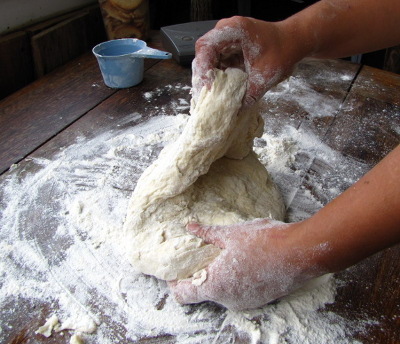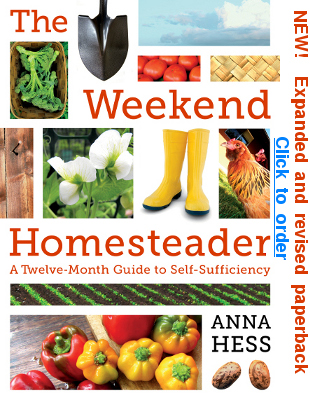
Kneading bread dough
 When all of the ingredients
are in the bowl and the dough is getting
hard to stir, clean off a table or countertop, toss down a handful of
flour to keep the dough from sticking, and pour the contents of your
bowl onto the counter. Knead the bread by stretching it out, then
folding it in half, turning ninety degrees after each stretch and
fold. You may have to add a bit more flour to keep the dough from
sticking to your hands and the counter, but try not to add too much ---
a slightly sticky dough will produce fluffier bread.
When all of the ingredients
are in the bowl and the dough is getting
hard to stir, clean off a table or countertop, toss down a handful of
flour to keep the dough from sticking, and pour the contents of your
bowl onto the counter. Knead the bread by stretching it out, then
folding it in half, turning ninety degrees after each stretch and
fold. You may have to add a bit more flour to keep the dough from
sticking to your hands and the counter, but try not to add too much ---
a slightly sticky dough will produce fluffier bread.
Gluten isn't only important for the texture of the bread --- it helps dough rise as well. When yeast excretes carbon dioxide, strands of gluten trap that gas within the dough. Without gluten, your bread would rise a bit, then fall.
The amount of gluten in your bread will depend on two factors. First is the length of your kneading time. Bread products that don't need much gluten (like pizza crusts) don't have to be kneaded very long, but if you want fluffy whole wheat bread, you might have to knead for as much as half an hour.
Type of flour is just as important as length of kneading. If you use a low protein flour like all-purpose wheat flour, there simply won't be enough protein present to create as many gluten fibers. Flours made from grains other than wheat can be high in protein but lack the specific proteins used to create gluten. Finally, whole wheat flour has another problem --- the tough bran particles cut through the gluten, fragmenting the fibers even as you knead. That's why it's often helpful to add some gluten to your recipe if you want fluffy bread made with flours other than wheat bread flour.
 For a white bread like
this one, ten minutes of kneading is
sufficient. It's not mandatory, but you'll find it easier to
knead your dough if you stop after the first five minutes and give your
dough five or ten minutes to relax before finishing the kneading
process.
For a white bread like
this one, ten minutes of kneading is
sufficient. It's not mandatory, but you'll find it easier to
knead your dough if you stop after the first five minutes and give your
dough five or ten minutes to relax before finishing the kneading
process.
Stay
tuned for more on the science and practice of
bread-baking at lunchtime for the rest of the week. Don't want to
wait for future installments? The
information is excerpted from Weekend
Homesteader: January, which is available for free on
Amazon from today until December 23! I hope you'll give the
entire book a try (and leave me a review!)
| This post is part of our Bread lunchtime series.
Read all of the entries: |
Want more in-depth information? Browse through our books.
Or explore more posts by date or by subject.
About us: Anna Hess and Mark Hamilton spent over a decade living self-sufficiently in the mountains of Virginia before moving north to start over from scratch in the foothills of Ohio. They've experimented with permaculture, no-till gardening, trailersteading, home-based microbusinesses and much more, writing about their adventures in both blogs and books.
Want to be notified when new comments are posted on this page? Click on the RSS button after you add a comment to subscribe to the comment feed, or simply check the box beside "email replies to me" while writing your comment.
